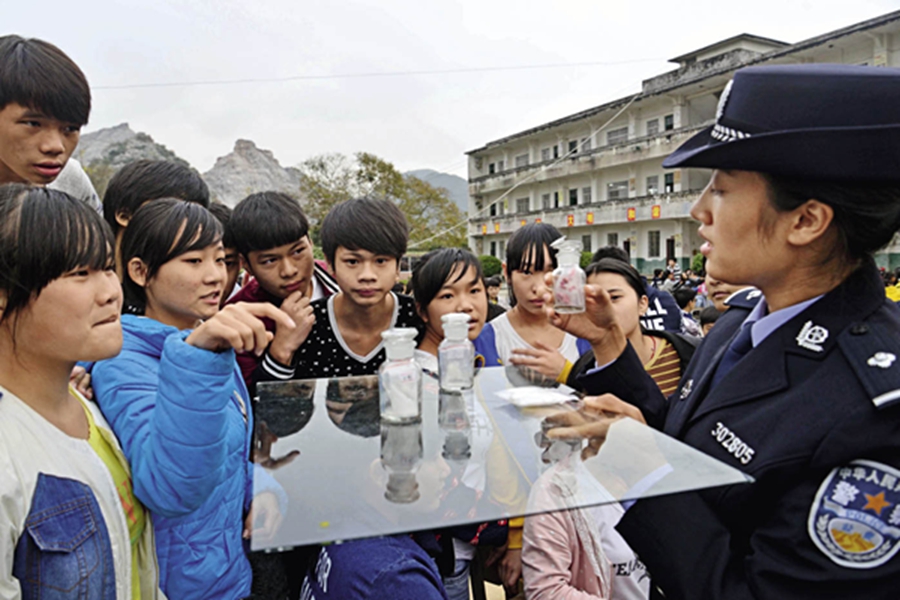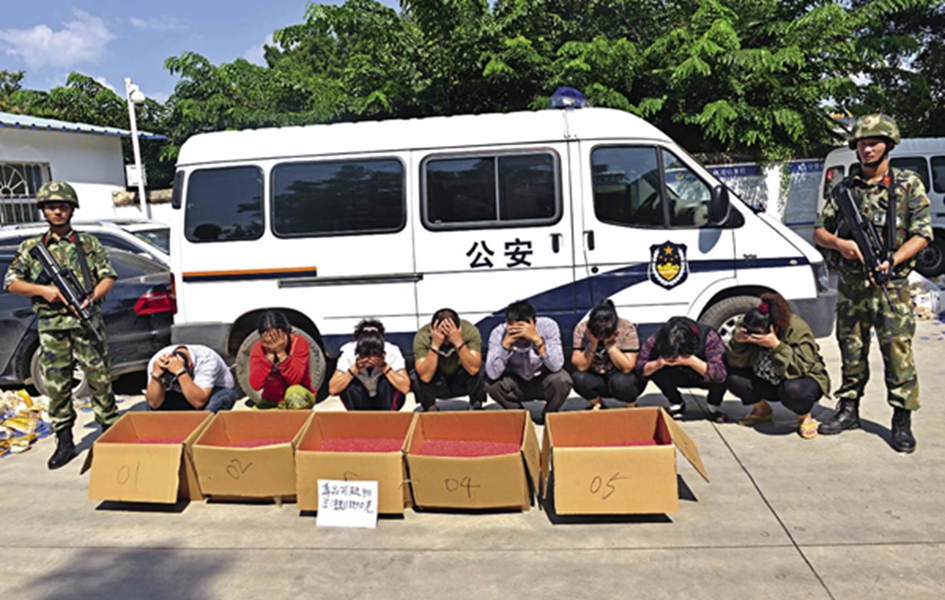POP singer Yin Xiangjie was arrested in November 2015 for drug use and possession, four months after finishing a seven-month prison term for the same crime.
Two weeks later Mao Ning, another singer dubbed in the late 1990s as the “love song prince,” was caught using narcotics. These entertainers are just two of a growing list of showbiz personalities that in recent years have been put behind bars for illegal drug use.
The same month, 16 minors from a Beijing music school tested positive for illegal substances when caught in a police raid carried out after a tip-off. Earlier that year the mayor of Linxiang in Hunan Province was investigated and later prosecuted on multiple charges that included illegal drug use.

Police officers show students at Yueshan Middle School, Yongfu County, Guangxi Zhuang Autonomous Region, how to identify illicit drugs.
These shocking events corroborate the assertion in the 2015 annual report on China’s narcotics problems that drug users in China are more diversified than ever before. Their numbers have expanded from the unemployed youth, farmers, migrant workers, and small private business owners of the past to workers in public institutions, freelancers, entertainers, even public servants.
The growing percentage of younger addicts is another alarming trend. Of the 2.345 million drug abusers nationwide, 1.8 percent, or 43,000, are under the age of 18, and those aged 18 to 35, totaling 1.42 million, account for 60.6 percent.
“Among the illegal drug users we have come into contact with, one first experimented with them at age 11,” deputy chief of the drug rehab center of Beijing Municipal Public Security Bureau Zhu Zhiwei said. “As their neuro systems are still immature, and their views on life and the world naive, young people are particularly vulnerable to the devastating, long-term damage that drugs inflict.”
A Growing Threat
China had 2.95 million registered drug addicts at the end of 2014, but the actual number is thought to exceed 14 million. That means one out of every 100 Chinese may have used illegal substances. The 2015 figure dipped slightly to 2.345 million (excluding former users that had not relapsed three years after rehab, and those who had left the country).
These figures are alarming in a country which barely two centuries ago the opium trade dragged into foreign invasions and exploitation, semi-colonization, and economic destruction. The narcotics scourge had been almost eradicated after the founding of the People’s Republic of China in 1949, but its specter has reemerged in recent decades due to the country’s economic boom and greater exposure to the rest of the world.
The spread of traditional illicit drugs such as heroin has been largely curbed, but the number of registered synthetic drug addicts has risen, year-on-year, by 40 percent. Of the 531,000 first-time drug abusers arrested last year, as many as 80.5 percent were habitual synthetic drug users, and 73.2 percent took various forms of amphetamines.

Local police raid a Karaoke bar in Shanwei, Guangdong Province, on August 9, 2015.
As Liu Yuejin, vice director of the National Narcotics Control Commission, observed in an interview last year, synthetic drugs are easier, quicker and hence cheaper to produce when compared to heroin, which originates in opium poppies and needs to be extracted and processed. “Synthetics are simple. One can make them in the kitchen at home,” Liu said.
What’s more, recent memories of the dire consequences of opium addiction, as elaborated in China’s history textbooks, make Chinese people particularly wary of and indeed averse to heroin. But they are less aware of the dangers of newer drugs, and that developing an addiction to synthetic drugs takes longer, which adds to their appeal. As, to start with at least, most people do not feel compelled to regularly consume such “designer” drugs, they do not see any risk attached to them until too late.
Jeopardizing Health, Life and Society
Synthetic drugs are just as dangerous, if not more so, as conventional ones. A 2011-2014 study by anti-drug authorities in Hami of eastern Xinjiang Uygur Autonomous Region, near the notorious Golden Crescent, shows that 96.34 percent of synthetic drug addicts admitted to the local rehab center were financially ruined, and 54.88 percent divorced. A survey by Kunming City, Yunnan Province, close to the Golden Triangle, showed similar findings: about half of local addicts were self-employed, and as many as 71 percent were more or less broke.
The amount drug users spend on their illegal habits is estimated at RMB 40,000 to RMB 50,000 per person per year. As the number of Chinese addicts now tops 10 million, drugs therefore sap upwards of RMB 500 billion from the national economy. The health and social hazards of illicit drug use are also immense; there is a 3.5 percent rate of HIV/AIDS among heroin users. In 2015 there were 174,000 narcotics cases across China that accounted for 14 percent of all criminal cases nationwide that year. They included 716 instances of homicide, kidnapping, and rape.
Comprehensive Countermeasures
In recent years the government has ratcheted up efforts to rein in and root out the drugs scourge. In 2015 police busted 165,000 drug cases – 13.2 percent more than in 2014, arrested 194,000 suspects – 15 percent more than in 2014, and seized 102.5 tons of various types of narcotics – 48.7 percent more than in 2014.
In response to the growing trend of drug producers, dealers, and buyers exploiting new technologies and channels, such as the Internet, online payment, and courier services, the National Narcotics Control Commission recently set up a special team to coordinate different government departments at various levels to clean up the virtual environment.

The Xishuangbanna, Yunnan Province, frontier security team arrests members of a clan of drug traffickers.
Last April the commission launched a nationwide campaign targeting online drug crimes. By mid-June, 832 domestic websites had been closed down due to drug violations, 1,471 websites registered outside China were blocked, 15,000 cases were investigated, and 3.3 tons of illegal substances seized.
Last June an anti-drug information platform opened on WeChat, widely-used instant messaging service. Central and local authorities also have anti-drug accounts on Sina Weibo, the popular micro-blogging service.
Drugs internationally trafficked into China come mainly from the Golden Triangle to its south. Last year heroin and “ice” smuggled from there into the four Chinese provinces and autonomous regions of Yunnan, Guangxi, Sichuan, and Guizhou accounted for a staggering 83 percent of the country’s total seizure of heroin and 93.3 percent of “ice” that it confiscated. Meanwhile, the Golden Crescent in Central Asia, centered on Afghanistan, where poppy plantations are estimated to cover 183,000 hectares, is also a looming threat.
Cooperation with countries in the two regions, therefore, is vital. In its global hunt for and deterrence of drug crimes, China maintains extensive contacts with the U.S., EU, Australia, and certain African and Latin American countries, and prioritizes collaboration with them. These efforts have paid off. In 2015 China received 202 requests to carry out drug investigations based on tip-offs from 29 countries and regions.
Last September a meeting on drug intelligence exchanges between China and the U.S. convened in Beijing. Officials from both sides discussed relevant policies, regional drug situations, and specific counter-drug actions. They reached consensus on bilateral exchanges focusing on drug testing technologies and training programs.
It is now globally recognized that drug prevention efforts should be targeted at younger people. China is in the midst of a campaign among schoolchildren that promotes anti-drug awareness through films and exhibitions, writing competitions, and anti-drug themed classes. So far it has covered 121 million students in more than 240,000 schools across the country.
What’s more, last year 14 central departments, including the National Narcotics Control Commission and the Ministry of Education, jointly worked out the National Plan of Drug Prevention Education for Adolescents and Youths (2016-2018), which targets the population aged between 10 and 25. It requires at least one (two in some regions) classes on drug prevention per school year, and incorporation into mandatory courses like Chinese language, history, chemistry, and biology of relevant content in this regard. The National Narcotics Control Commission and the Ministry of Education have also designed and produced educational films and courses for primary, middle and vocational schools which it makes available for downloading to their websites.
As complex and widespread as it is, the drug problem demands long-term efforts and a holistic approach. It must be decisively and effectively dealt with, because drugs poison the body and mind of an individual and hence affect their family, community, and the nation, so ruining the very fabric of human society.
